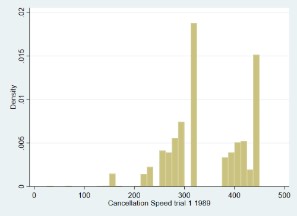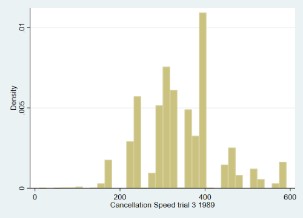The MRC National Survey of Health of Development (NSHD) assessed their cohort members (CMs) during the study’s age 43 sweep using the Timed Letter Search/Letter Cancellation Test.
Details on this measure and the data collected from the CMs are outlined in the table below.
| Year of data collection: | 1989 | ||
| Domain: | Processing speed | ||
| Measures: | Attention/concentration | ||
| Mental speed | |||
| Visual scanning | |||
| CHC: | Gv (Visual Processing) | ||
| Gs (Processing Speed) | |||
| CLOSER Source | Explore this sweep in CLOSER Discovery: NSHD 1989 (Age 43) (opens in a new tab) | ||
| Administration method: | Research nurse; face to face; pen and paper | ||
| Procedure: | The participant was given a page consisting of three blocks of random letters arranged in rows (15, 17, 20 letters) and columns (all 30 letters). Beginning with the first block, they were instructed to cross out as many target letters ("Ps" and "Ws") as possible within a one-minute timeframe (the interviewer demonstrated). They were instructed to move onto the second block once the first minute was up, and then move to the final block once the second minute was up. The test was stopped at the end of the third minute. Respondents were instructed to work across each row from left-to right as if they were reading a page and they were asked to perform the task as quickly and accurately as possible. | ||
| Link to questionnaire: | https://skylark.ucl.ac.uk/NSHD/lib/exe/fetch.php?media=questionnaires:1989_a_main.pdf (opens in new tab) | ||
| Scoring: | The number of hits, misses and row/column reached were recorded, meaning multiple scoring schemes are possible. Although there is no definitive scoring system used, the most widely adopted approach is to calculate speed (number of letters scanned) and accuracy (dividing the number of missed targets for each trial by the corresponding speed score). | ||
| Item-level variable(s): | VSCL189 - VSRW389 | ||
| Total score/derived variable(s): | CANSP189, CANSP289, CANSP389, CANSPa89 Explore these variables in CLOSER Discovery: NSHD 1989 Self Completion Questionnaire Dataset (opens in a new tab) |
||
| Descriptives: | Trial 1 (raw score) | Trial 2 (raw score) | Trial 3 (raw score) |
| N = 3,151 | N = 3,155 | N = 3,139 | |
| Range = 25 - 450 | Range = 38 - 509 | Range = 10 - 591 | |
| Mean = 343.80 | Mean = 339.41 | Mean = 342.80 | |
| SD = 76.70 | SD = 85.12 | SD = 90.42 | |
(Click image to enlarge) | (click image to enlarge) | (click image to enlarge) |
|
| Age of participants (months): | Mean = 521.84, SD = 2.19, Range = 514 - 533 | ||
| Other sweep and/or cohort: | NSHD – Age 53 – Timed Letter Search/Letter Cancellation Test* | ||
| NSHD – Age 60-64 – Timed Letter Search/Letter Cancellation Test* | |||
| NSHD – Age 68-70 – Timed Letter Search/Letter Cancellation Test* | |||
| NCDS – Age 50 – Timed Letter Search/Letter Cancellation Test* | |||
| NCDS – Age 61-63 – Proposed repeat of tests at age 50 | |||
| BCS70 – Age 46-47 – Timed Letter Search/Letter Cancellation Test* | |||
| (*Only included in 1 trial) | |||
| Source: | The letter cancellation test was adapted from the MRC Cognitive Function and Ageing Study (MRC CFA Study, 1998). | ||
| Technical resources: | None | ||
| Example articles: | Richards, M., Kuh, D., Hardy, R., & Wadsworth, M. (1999). Lifetime cognitive function and timing of the natural menopause. Neurology, 53(2), 308-308. | ||
| Richards, M., Hardy, R., Kuh, D., & Wadsworth, M. E. (2001). Birth weight and cognitive function in the British 1946 birth cohort: longitudinal population based study. BMJ, 322(7280), 199-203. | |||
For the named items in the table above, links are provided to their corresponding content on CLOSER Discovery. Where a variable range is provided, full variable lists can be accessed through the ‘Variable Groups’ tab on the linked Discovery page.
Go to:
- Overview of all cognitive measures in NSHD
- Overview of adulthood cognitive measures across all studies
This page is part of CLOSER’s ‘A guide to the cognitive measures in five British birth cohort studies’.
